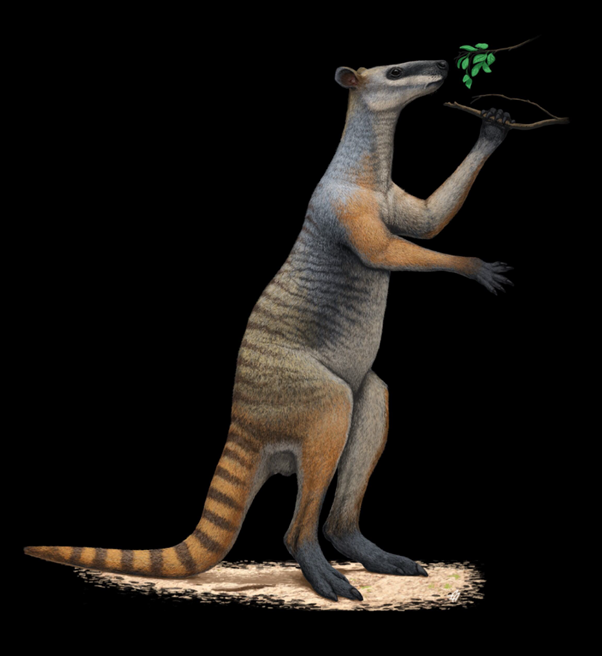Bigger mammals usually roam more widely than smaller relatives, but fossils indicate this wasn’t true for extinct giant kangaroos. The findings could help explain the extinction of these great beasts as climate change made their home ranges unviable.
Australia is famous for its existing strange beasts, but that is nothing to what it had in the past. Compared to giant ducks of doom and 3-ton (sort of) wombats, giant kangaroos may seem positively normal, but they still represent an amazing feature of a lost world.
Protemnodon is an extinct genus of kangaroo that lived in Australia and New Guinea and grew to an estimated 170 kilograms (370 pounds). Today the largest members of the kangaroo family, Osphranter rufus, average 50 kilograms (110 pounds), although some individuals reach almost twice that. Seven Protemnodon species are suspected, although there is still debate as to whether some of these were really the same.
Some Protemnodon species survived in Australia until 50,000 years ago. The timing of their extinction has led to passionate debates as to whether climate change or the arrival of humans brought about their demise.

Artist’s impression of Protemnodon. The length of its arms suggests it may have moved on all fours, rather than bounding like modern kangaroos.
Image credit: Atuchin/Lawrence/Hocknull
The locations where we find fossils are poor guides to their range, since circumstances suited to preserving teeth or bones are rare. However, these fossils can sometimes reveal where the animal fed, because rare elements in the water or food supply become incorporated in the bones.
University of Wollongong PhD student Christopher Laurikainen Gaete studied the strontium isotopes in Protemnodon teeth collected around Queensland’s Mount Etna, where Protemnodon was known to live 280,000 to 500,00 years ago. He found their food supply came overwhelmingly from the local area where limestone dominates, indicating a small home range. This, Gaete and co-authors note, was unexpected, because usually larger animals have bigger ranges. Certainly, the largest surviving kangaroos bound their way across immense distances, allowing them to take advantage of rainfall in arid lands.
From 500,000 to 280,000 years ago the climate of the area does not seem to have changed a lot. After that it became much more unstable.
Christopher Laurikainen Gaete
Protemnodon specimens are thought to have ranged in size from 90 to 170 kilograms (200-370 pounds), so their habitats might have been expected to be proportional. However, their skeletons suggest they may have got around on all fours, rather than hopping. That’s not a total surprise. Hopping is an exceptionally efficient method for covering ground, but it’s thought there is a maximum body mass beyond which tendons can’t handle the shock. It’s plausible Protemnodon exceeded that. Certainly, it’s best not to take internet memes of T. rexes bounding like kangaroos too seriously.
If Protemnodon was ill-suited to long travel, Gaete and co-authors suspect, it might have struggled to reach new locations when climatic changes made its habitat unsuitable. Gaete told IFLScience, “From 500,000 to 280,000 years ago the climate of the area does not seem to have changed a lot. After that it became much more unstable.” This would have led to periods where the rainforest that provided Protemnodon’s food was replaced by drier forests they couldn’t eat.
Why Protemnodon got so big in the first place, if it wasn’t to range further, is unclear. Gaete told IFLScience it may have been as simple as being able to reach leaves on higher branches than other forest-dwellers.

Senior author Scott Hocknull holding a Protemnodon skull, showing just how big these got.
Image credit: Scott Hocknull
The teeth on which the study was based clearly belonged to Protemnodon, but the exact species is uncertain. “There was a species identified as living around Mount Etna, but a 2024 study nullified that description, so we don’t know which one this was,” Gaete told IFLScience.
Other Protemnodon probably occupied different niches, allowing the genus as a whole to survive until 50,000 years ago (or possibly 12,000 in New Guinea). That means the debate as to whether humans struck the final blow will continue. Nevertheless, it seems that a combination of preferring homelife to roaming, and a more unstable climate, probably made the entire genus vulnerable well before that.
The study is published open access in PLOS One.
Source Link: Ancient Giant Kangaroos Were Homebodies, New Study Concludes, Contributing To Their Extinction